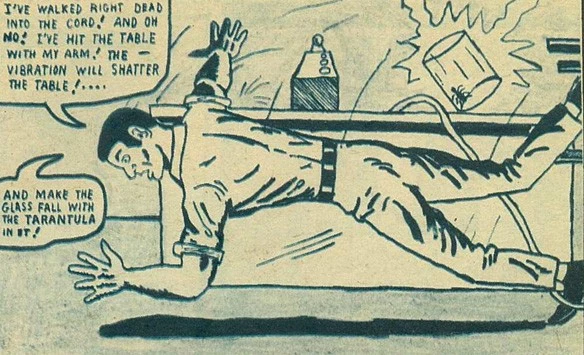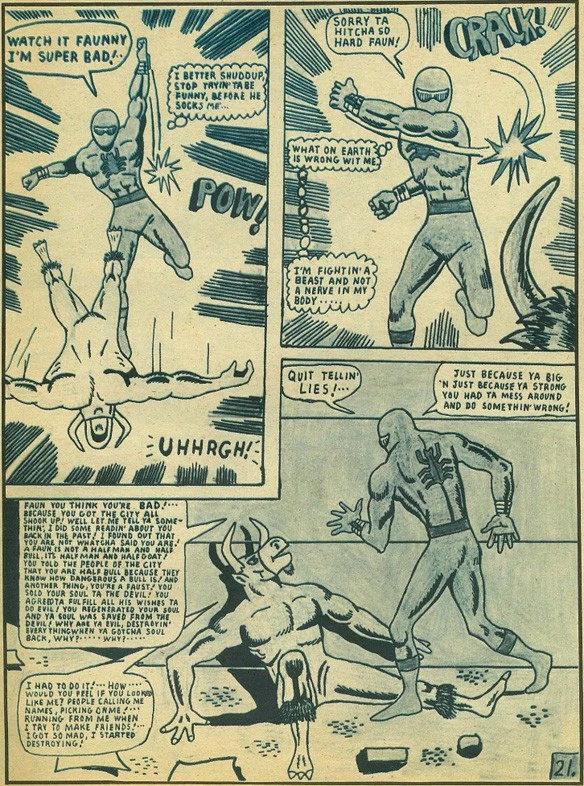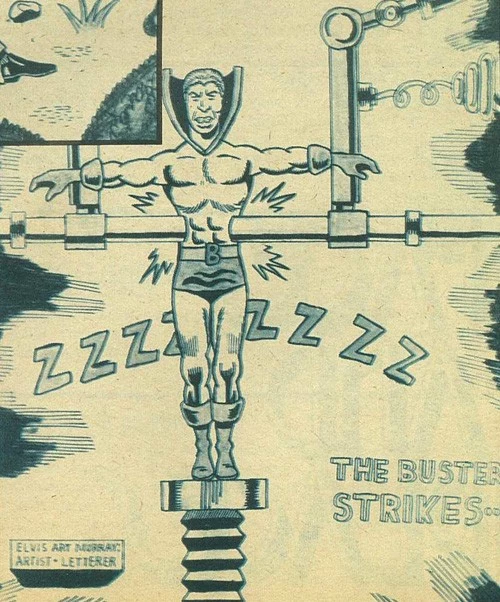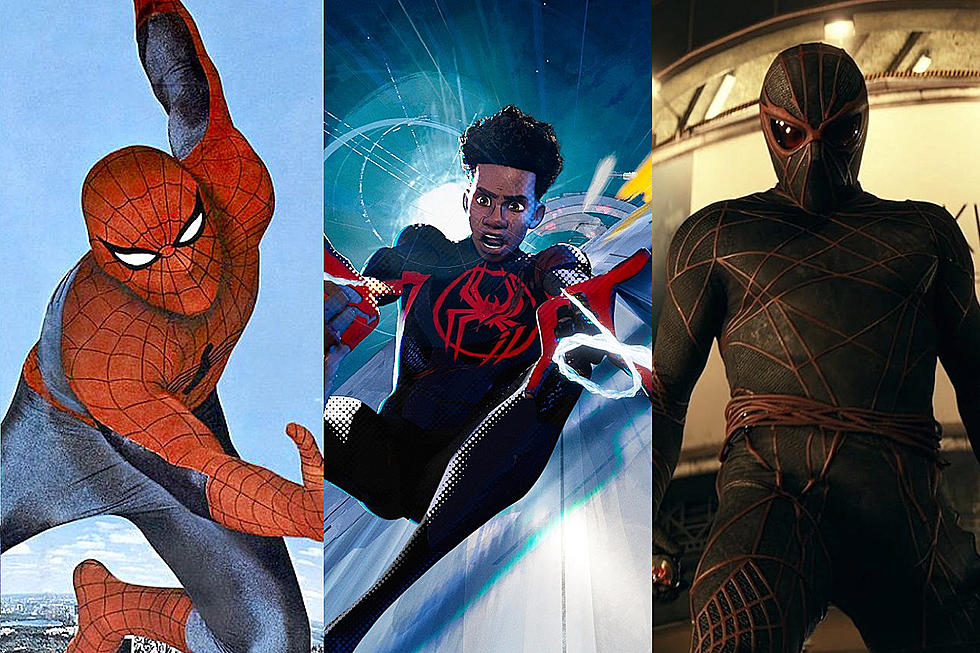
Bizarro Back Issues: The Tarantula Is Definitely Not Spider-Man (1972)

If you attended elementary school sometime in the past forty years or so, you may already be familiar with Scholastic Scope, a Language Arts-themed magazine for students put out in order to encourage reading, and therefore the purchase of the many fine books available from Scholastic Publishing. What you may not know, however -- and what I didn't know until pal Andrew Weiss sent me this particular issue -- is that back in 1972, they debuted an exciting new super-hero!
See, he was bitten by a radioactive spider and then vowed to use his incredible wall-crawling abilities to protect the people of New York City. His name was the Tarantula, and as the magazine would assure you, he was definitely not Spider-Man. At all. (Cough.) The Tarantula was the product of a young man with an awesome name, 15 year-old Elvis Murray of Washington DC, and before we go any further, I want to stress that I'm not trying to rip on a guy for a comic that he made when he was a teenager. Don't get me wrong, it's clear from the start that Murray's doing a pretty blatant take on Spider-Man -- even Scholastic can't get through their introduction to the comic without pointing out the similarities, and that thing's about as blissfully oblivious as you can get -- but as far as I know, that's how most artists get their start. Most of them just don't end up having their stories reprinted in a magazine.
The Tarantula was the product of a young man with an awesome name, 15 year-old Elvis Murray of Washington DC, and before we go any further, I want to stress that I'm not trying to rip on a guy for a comic that he made when he was a teenager. Don't get me wrong, it's clear from the start that Murray's doing a pretty blatant take on Spider-Man -- even Scholastic can't get through their introduction to the comic without pointing out the similarities, and that thing's about as blissfully oblivious as you can get -- but as far as I know, that's how most artists get their start. Most of them just don't end up having their stories reprinted in a magazine.
And it's not just something artists do, either. Most kids who are into comics try to make their own versions of their favorites when they're kids -- I know I did, and I didn't even have the sense that Murray did to change the names. It was just straight up a colored pencil version of Batman #425 (the one where Batman wrecks a bunch of dudes in a junkyard) that I drew over a week at Myrtle Beach when I was ten, except that he fought Blanka and Dhalsim from Street Fighter II instead of a murderous ambassador with diplomatic immunity.
Unlike me, Murray had quite a bit of talent, which is pointed out by no less of an authority than legendary Spider-Man artist John Romita Sr., who is featured in the article to give his opinion on Murray's pages. As he points out, Murray's not really copying drawings from Marvel's flagship webslinger, and while his art is what you'd expect from a kid who's still in high school, he's actually not bad. Of course, that doesn't mean he's not copying everything else, or that this story isn't wonderfully bizarre, both of which are definitely the case.
Rather than mild-mannered Peter Parker, Murray's story opens on scientist Dave McQueen, who is super-stoked about this button he's about to press:

Why? Because that button is the culmination of his latest experiment, which is designed to make a tarantula grow larger! This, of course, begs the question of just why the hell anyone would want to make a giant tarantula. Seriously, we're exactly three panels into this story, and I'm having severe doubts over whether Dave McQueen isn't actually a madman bent on showing them, showing them all. Fortunately for everyone concerned, the tarantula stays in its more manageable size, though it does take on the strange glow of radiation. You can probably guess where this is going.
Adding to my theory that McQueen is on the path to super-villainy: His reaction when his experiment is interrupted by a phone call from his girlfriend:

This may actually be my single favorite panel in the entire story, as it is the perfect representation of what you think grown-up relationships are like when you grow up reading Marvel Comics from the '60s and '70s. Girlfriends! Always interrupting SCIENCE!
As McQueen gets up to answer the phone and chide his special lady (who sadly does not appear in the story) for standing in the way of the bleeding-edge science of tarantula growth, he trips over his Tesla coil's power cord and engages in what is either the fastest talking or the slowest falling I have ever seen:

Fifteen years old, and Murray had already mastered the art of the mid-action descriptive monologue that took Silver Age writers years of practice. I'm not even kidding when I say that's pretty impressive.
Rather than the instant super-death that one would assume would come from a sharp blow to the head and a bite from a radioactive tarantula, McQueen wakes up with only a headache and some light dizziness to show for his trouble. Of course, when he walks over to the window to grab some fresh air, he falls out, but is able to stop himself because he can stick to walls!

Just like a... a tarantula! That's the ticket!
At this point, Scope edits out a few pages -- it was a short magazine to begin with, and Murray was doing Tarantula as a series of full-length, 24-page comics, another aspect of his work that's pretty impressive, especially since he was doing actual comic book-style page layouts with six and seven panels each. When we pick up, though, we're introduced to the villain of the piece: THE NOTORIOUS FAUN!

The Faun is, of course, named for the obscure half-goat forest god of Roman mythology, and is not to be confused with Marvel's Man-Bull (1971). You can tell them apart because Man-Bull doesn't have Frankenstein hair and what appears to be a duck's face. At least, not outside of his Facebook photos.
Even though the (notorious) Faun is "the strongest that ever existed," Tarantula is up for the challenge of protecting the good citizens of New York with the proportionate strength of... an unspecified member of the arachnid class. And this is -- and again, I mean this completely unironically -- where Murray really shines as a writer. Rather than Peter Parker's boisterous fight banter, Murray makes McQueen sound like a super-heroic version of Muhammad Ali, right down to the rhymes:

Admittedly, they're in there with that massive exposition about how Faun is actually a half-goat Faust who sold his soul to the devil (which I really hope was addressed somewhere in the 17 pages that didn't make the cut), but those lines about being big and strong and messin' around and doing somethin' wrong are pretty fantastic. If nothing else, the idea of the Faun turning to a pact with Satan because he has trouble making friends is definitely on par with Stan Lee's usual shots at pathos.
Thus, Evil is defeated and the Tarantula's exploits are reported in a newspaper that I can only assume is called the Daily Trumpet:

In further adventures, Tarantula would go on to fight Alligator-Man, who was definitely not the Lizard, and the Buster, who some of you may remember would re-emerge 20 years later as a noted foe of Dr. Dre and Snoop Dogg.
As for Murray's further adventures, I'm honestly surprised that he never showed up as a comics pro. For being 15 when he wrote and drew this, he has a pretty solid grasp of storytelling, and his art definitely seems like he could've gotten better with more practice. I genuinely wonder whether he just fell out of comics in favor of other pursuits, or if he was just bummed out when Marvel introduced their own Tarantula two years later (although they'd used the name earlier in 1967).
Either way, if anyone knows what this dude's deal was...

...let me know as soon as possible.
More From ComicsAlliance









